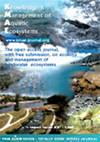考虑中生境尺度的冲沙生态影响评价
IF 1.7
3区 环境科学与生态学
Q3 FISHERIES
引用次数: 2
摘要
底栖大型无脊椎动物对表征自然生境的几个因素作出反应,如水深、水流和河床基质。因此,改变这些因素的人为干扰可能对底栖动物产生不同的影响,这也取决于中生境。这些干扰包括泥沙冲刷作业,这些作业通常是为了恢复水库容量而进行的,在中生境尺度上调查其影响可能与对这些作业进行适当的生态影响评估有关。在这里,我们比较了在阿尔卑斯河流的三种不同的中生境(池、沟和阶梯池)进行控制沉积物冲刷操作前后取样的底栖大型无脊椎动物群落。与预期相反,大型无脊椎动物组合的组成在中生境之间没有显著差异。此外,沉积物冲刷对密度的影响比丰富度的影响更显著。我们测试了两个压力源特异性指数,但只有一个(LoTic生态系统淤积指数- SILTES)清楚地检测了沉积物冲刷对大型无脊椎动物群落结构的影响。最后,无论是单独考虑三种中生境,还是考虑所有可能的组合,在时间轨迹和恢复时间上,各中生境之间都存在一些差异。其中,河床是最敏感的中生境,在泥沙扰动后1年仍未完全恢复。本文章由计算机程序翻译,如有差异,请以英文原文为准。
Considering mesohabitat scale in ecological impact assessment of sediment flushing
Benthic macroinvertebrates respond to several factors characterizing the physical habitats, as water depth, current and streambed substrate. Thus, anthropogenic disturbances altering these factors may have different effects on benthos, also depending on mesohabitats. These disturbances include sediment flushing operations, commonly carried out to recover reservoir capacity, and investigating their effects at mesohabitat scale could be relevant for an adequate ecological impact assessment of these operations. Here, we compared benthic macroinvertebrate communities sampled before and after a controlled sediment flushing operation in three different mesohabitats (a pool, a riffle and a step-pool) of an Alpine stream. Contrary from expectations, the composition of macroinvertebrate assemblages was not significantly different among mesohabitats. Moreover, the impact of sediment flushing was more significant in terms of density rather than in richness. Two stressor-specific indices were tested, but only one (the Siltation Index for LoTic EcoSystems − SILTES) clearly detected the impact of sediment flushing on the macroinvertebrate community structure. Finally, some differences in the temporal trajectories and recovery times to pre-flushing conditions were observed among mesohabitats, both if the three mesohabitats were considered separately and if all their possible combinations were accounted for. Particularly, riffle was the most sensitive mesohabitat, not fully recovering one year after the sediment disturbance.
求助全文
通过发布文献求助,成功后即可免费获取论文全文。
去求助
来源期刊

Knowledge and Management of Aquatic Ecosystems
环境科学-海洋与淡水生物学
CiteScore
3.70
自引率
5.60%
发文量
22
审稿时长
>12 weeks
期刊介绍:
Knowledge and Management of Aquatic Ecosystems (KMAE-Bulletin Français de la Pêche et de la Pisciculture since 1928) serves as a foundation for scientific advice across the broad spectrum of management and conservation issues related to freshwater ecosystems.
The journal publishes articles, short communications, reviews, comments and replies that contribute to a scientific understanding of freshwater ecosystems and the impact of human activities upon these systems. Its scope includes economic, social, and public administration studies, in so far as they are directly concerned with the management of freshwater ecosystems (e.g. European Water Framework Directive, USA Clean Water Act, Canadian Water Quality Guidelines, …) and prove of general interest to freshwater specialists. Papers on insular freshwater ecosystems and on transitional waters are welcome. KMAE is not a preferred journal for taxonomical, physiological, biological, toxicological studies, unless a clear link to ecological aspects can be established. Articles with a very descriptive content can be accepted if they are part of a broader ecological context.
 求助内容:
求助内容: 应助结果提醒方式:
应助结果提醒方式:


